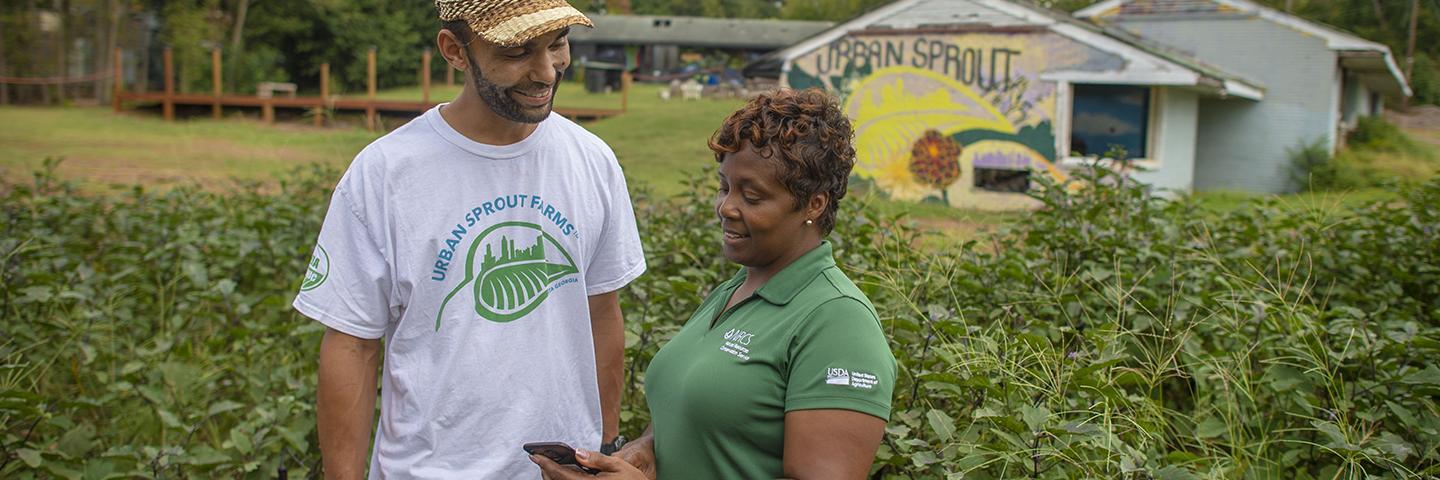Environmental Quality Incentives Program - MO
The Environmental Quality Incentives Program (EQIP) provides financial and technical assistance to agricultural producers and non-industrial forest managers to address natural resource concerns

Are you farming or gardening in a city or suburb? Urban agriculture provides critical access to healthy food for local communities, as well as jobs, increased green spaces, and closer community ties.
Urban agriculture pioneers are taking action in their communities. As American agriculture continues to grow in new directions, NRCS conservation assistance in Missouri is growing along with it.
Urban agriculture includes the cultivation, processing and distribution of agricultural products in urban and suburban areas. Community gardens, rooftop farms, hydroponic, aeroponic and aquaponic facilities and vertical production are all examples of urban agriculture. Tribal communities and small towns may also be included.
NRCS offers technical and financial assistance with conservation practices, including:
Through free technical assistance, NRCS can help you identify your goals and develop a conservation plan.
Contact the NRCS at your local Service Center to learn more. If you need information in a language other than English, we offer free translation services at our Service Centers.
Application deadline: Aug. 1, 2023
NRCS in Missouri will accept applications until Aug. 1, 2023, for the EQIP St. Louis Urban Hub Initiative. Applications submitted prior to this date will be assessed and ranked as soon as the applicant has made treatment decisions through a conservation plan.
Based on fund availability, eligible applications that meet a minimum threshold score of 30 will be preapproved immediately, allowing the applicant to ACT NOW. Application assessments below the minimum threshold will be batched and funded in ranking order as funding allows.
The St. Louis Urban Hub Initiative is focused on assisting urban and small farmers within the St. Louis Urban Hub geographical area address resource concerns on their operations. Urban and small farmers provide critical access to healthy food for local communities, as well as jobs, increased green spaces, and closer community ties.
For a map of the area covered by this initiative please see attachment below.
Please contact Sarah Szachnieski, NRCS Urban Conservationist at (314) 457-4746 or sarah.szachnieski@usda.gov for assistance with this initiative.
Application deadline: May 23, 2023
People’s Gardens empower communities to participate in local food production and provide diversity and resiliency to the food supply chain. They also teach about the benefits of sustainable, local agriculture and how gardening can foster community collaboration, provide green gathering spaces, and benefit the environment. In order to be eligible for PGI funding, a garden must meet the three criteria below:
USDA renewed the People’s Garden movement in 2022 to:
These gardens incorporate sustainable practices, many of which are rooted in conservation practices that NRCS helps farmers and ranchers with across the country. For example, read more on soil health and the importance of pollinators.
People’s Gardens grow fresh, healthy food and support a resilient, local food system; teach people how to garden using sustainable practices; and nurture habitat for pollinators and wildlife, and greenspace for neighbors to gather and enjoy. People’s Gardens all:
Contact your local service center to start your application.
Do you farm or ranch and want to make improvements to the land that you own or lease?
Natural Resources Conservation Service offers technical and financial assistance to help farmers, ranchers and forest landowners.

To get started with NRCS, we recommend you stop by your local NRCS field office. We’ll discuss your vision for your land.
NRCS provides landowners with free technical assistance, or advice, for their land. Common technical assistance includes: resource assessment, practice design and resource monitoring. Your conservation planner will help you determine if financial assistance is right for you.
We’ll walk you through the application process. To get started on applying for financial assistance, we’ll work with you:
Once complete, we’ll work with you on the application, or CPA 1200.
Applications for most programs are accepted on a continuous basis, but they’re considered for funding in different ranking periods. Be sure to ask your local NRCS district conservationist about the deadline for the ranking period to ensure you turn in your application in time.
As part of the application process, we’ll check to see if you are eligible. To do this, you’ll need to bring:
If you don’t have a farm number, you can get one from USDA’s Farm Service Agency. Typically, the local FSA office is located in the same building as the local NRCS office. You only need a farm number if you’re interested in financial assistance.
NRCS will take a look at the applications and rank them according to local resource concerns, the amount of conservation benefits the work will provide and the needs of applicants. View Application Ranking Dates by State.
If you’re selected, you can choose whether to sign the contract for the work to be done.
Once you sign the contract, you’ll be provided standards and specifications for completing the practice or practices, and then you will have a specified amount of time to implement. Once the work is implemented and inspected, you’ll be paid the rate of compensation for the work if it meets NRCS standards and specifications.